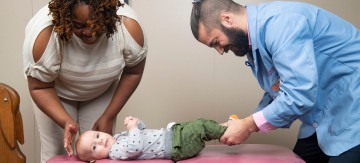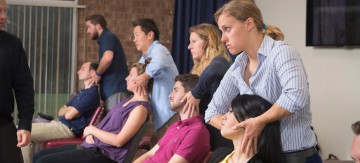Here’s a look at what to expect from the academic program at chiropractic college.
It is no secret that the doctor of chiropractic program is rigorous and challenging. You may hear professors describe it as “drinking water from a fire hydrant.” Becoming any type of doctor takes a lot of hard work and dedication. To complete the program successfully, you must be passionate about the profession, good with time management, and disciplined with your studies.
We know that becoming a doctor of chiropractic is no easy task, but nothing worth having or doing ever comes easily! Part of our job as admissions representatives is to ensure that prospective students understand exactly what it will take to become a chiropractor and all that you will need to get there. Here in the admissions office, we receive questions daily about the curriculum for the doctor of chiropractic program.
Before we get to the questions, let us cover some basic information. Sherman College of Chiropractic enrolls students once every quarter: winter, spring, summer and fall. Our program is 14 quarters long, totaling 3.5 years, year round, of academic study. Similar to high school, the same class that you start with will be the same class that you will graduate with. You will be with your classmates every class, every day, every quarter, so long as you do not fall behind in your coursework.
Students do not get to choose their chiropractic classes or professors like in undergrad. Each quarter there is a set schedule, and you will be required to take those classes during the days/times listed with the rest of your classmates. Depending on your class size, you may get to choose between two or three different schedules to ensure that our student-to-faculty ratio in technique, palpation and lab classes stays low. Lastly, there is a one-week break in the spring and the fall and a three-week break in the summer and the winter.
Now, let’s break down some of our most frequently asked questions!
Q: What is the average class size?
A: This is dependent upon the quarter that you enroll in. Fall class tends to be the largest; in fall 2020, we enrolled 54 students into the doctor of chiropractic program. Spring class is usually the smallest quarter; this spring we enrolled 20 students into the program. Regardless of your class size, we always keep an appropriate student-to-faculty ratio to ensure that our students’ needs are met.
Q: How many hours per day/week are spent in class?
A: Each quarter brings a new set of classes, which means that you may spend more or less time in the classroom depending on which quarter you are in. On average, students are on campus from 8 am – 4 pm, Monday through Friday. Currently, students get a two-hour break for lunch. Additionally, there will be days where you may have an additional break of an hour or two, depending on your schedule that quarter.
Q: What is the latest class offered at Sherman College?
A: As mentioned above, the course schedules change each quarter. Typically, during your second quarter, there is a lab class that ends at 7 pm, and this has historically been the latest class that our students have to take.
Q: How are the quarters alike or different from one another?
A: Each quarter is different from one another as you begin a new set of classes each time. The curriculum builds upon itself each quarter, meaning that you must learn everything in quarter one and pass each of your classes to fully advance to quarter two, and so on. You will get hands-on experience from your very first quarter on campus, though your later quarters will have more of an emphasis on chiropractic technique and more elective opportunities.
Q: What is the doctor of chiropractic program structure?
A: The doctor of chiropractic program is structured in a particular way to set you up to pass your national board exams. For example, quarters 1-6 prepare you to take your part 1 boards around the start of your 7th quarter. This continues for parts 2-4 of the national boards. The first half of the program is spent in the classroom taking classes such as philosophy, technique classes, palpation, basic sciences, etc. During your 8th quarter, you will start to transition to taking clinic-related classes. You will take your chiropractic clinic entrance exam during 8th quarter and you will receive your first patient, which will be a reciprocal in your class. In 9th quarter, you will be paired up with a first quarter student who will become your second patient. In 10th quarter, things really change as you move more into the clinical side of chiropractic and you can start seeing patients in our outpatient clinic. Your time spent in the classroom will start to decrease as you spend more time in the clinic. This will continue until you are finished with the program. During your 14th (final) quarter, you have the option to take the PMOE course, which stands for Practice Management Observation Elective. If you do this, you will work with a doctor in the field and shadow them for the quarter.
Q: How many electives are required, and what types of electives are offered?
A: You are required to take 55 elective hours for graduation. Electives include various technique classes, research classes, and clinical, diagnosis or radiology classes.
Q: What are the tests, midterms and final exams like?
A: While each class is different, the tests at Sherman College are set up to reflect the national board exams. They may be practical exams, multiple choice, short answer, and/or fill-in-the-blank questions.
Q: How available are the instructors after class?
A: Here at Sherman College of Chiropractic, we have an open-door policy. On campus you will notice that each door to the staff and faculty’s offices have glass windows. If they are in there, you are more than likely able to meet with them! Some of our professors hold other jobs outside of Sherman, so it is always best to make an appointment to meet with your professor to ensure that you are both available.
We hope we have helped to answer your questions and put your mind at ease about the doctor of chiropractic program at Sherman College. You can find our most recent curriculum guide here. If you have questions, or if you would like more information, please email admissions and we’ll be happy to help.






